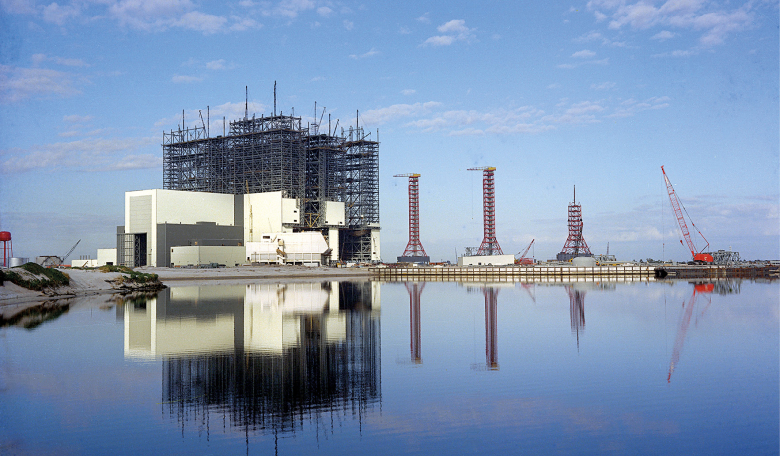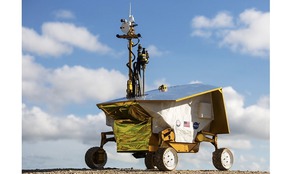The architecture of 20th and 21st century space exploration has left a definable mark on our Earthly landscape. Some of it is well known: think of the distinctive form of the Vehicle Assembly Building (VAB) at Cape Canaveral and the overused adjective ‘iconic’ comes quickly to mind. But much of it is less familiar, located for the most part out of the public eye in jungles, deserts or amid the Central Asian steppes. Now a new book, The Atlas of Space Rocket Launch Sites, by Brian Harvey with Gurbir Singh, offers a unique look at the physical footprints of Earth’s launch sites, the architecture that tells its own story of the past, present and future of space exploration.
There are now more than 30 rocket launch sites worldwide. Some, such as the Wenchang Space Launch Site in Hainan, China, are well known, even considered tourist attractions, while others such as the Plesetsk Cosmodrome in Russia are relatively unknown and Kapustin Yar, in Russia, is officially secret. Some, such as the Baikonur Cosmodrome were secret but are now largely open. And while Vandenberg Space Force Base in the US and Palmachim Airbase in Israel have limited access, the Semnan Space Center in Iran and Sohae Satellite Launching Station in the Democratic People’s Republic of Korea (DPRK) are impenetrable.
France’s Interarmy Special Vehicles Test Centre (CIEES) in Hammaguir, Algeria, is now an archaeological relic while at the other end of the spectrum, the Vostochny Cosmodrome in Russia is cutting-edge steel-and-glass modern.
There are now more than 30 rocket launch sites worldwide
For location, Japan’s island-based Tanegashima Space Center and China’s Xichang Satellite Launch Center in the misty mountains of Sichuan, cannot be beaten. Some launch sites avoided land altogether, using oil industry platforms, like Luigi Broglio Space Center’s (BSC) San Marco platform off Kenya and the Sea Launch platform, Ocean Odyssey, located in the central Pacific Ocean; or have launched satellites from aircraft (air launch) or even space stations.
Some sites have played pioneering historical roles, like the Thumba Equatorial Rocket Launching Station in Thiruvananthapuram, India, and others like Rocket Lab Launch Complex, on Mahia Peninsula in New Zealand and Kulasekarapattinam Spaceport, in India, are recent entrants to space launch.
While some, like NASA’s Wallops Flight Facility, have seen a resurgence, having ‘come back from the dead’, the most unfortunate launch site must be Brazil’s Alcântara Space Centre where two failed launches were followed by a catastrophic explosion and it has yet to launch successfully.
The busiest in the world for most of the Space Age was Plesetsk in Russia, its dominance ended only recently by the SpaceX Falcon 9 launching 50 Starlink satellites at a time from Cape Canaveral.
Key elements
From a functional point of view, the key elements required by any launch site are a launch pad, the core; a hangar in which to install a waiting rocket; a site transport system (rail or land); access transport (air, sea or rail); fuel tanks; fuelling facilities - pipes, pumps and hoses; high masts for lighting and to conduct lightning; launch control; and downrange tracking. Some, but not all, have a structure - normally steel - to house the rocket before take-off. Most have what are awkwardly called ‘integration facilities’; buildings where rockets, satellites and engines are put together, tested, assembled and checked. Some make on-site provision for their workforce. The more open ones have visitor centres. Given all this, it is not difficult to pick out the distinct elements of any launch site from an aircraft or satellite.
That may be obvious now, but was not the case when the first launch site was constructed at Peenemünde on the Baltic coast in the early 1940s. Britain had heard reports of a German rocket base, but did not know what exactly it was looking for. The cement stand in the middle of the forest, test stand 7 (Prüfstand 7), was the give-away and the first modern rocket, the A4 or V2 was fired from there on 3 October 1942. To this day, the cement stand has been a defining central feature of some launch sites, for example those of the DPRK and Iran.
Location
The negative impacts of new launch sites should not be underestimated
The key question for launch sites has been where to put them. As with Peenemünde, the coast has generally been first choice, because ascending rockets can soon be over water where, should they crash, they pose the least risk to humans below. It is no surprise that many of the world’s best-known sites are located close to the sea, be they sandy sea shores e.g., Cape Canaveral, Wallops Island (US); Sriharikota (India), Kourou (Europe) or hilly sea shore e.g., Vandenberg (US), Uchinoura, Tanegashima (Japan), Naro (Rep Korea), the latter posing construction challenges.
The second location of choice might be called ‘inland desert’. Generally, such sites have been chosen for security reasons. These are usually in unpopulated areas, though not as unpopulated as they might seem. The Soviet Union selected Kapustin Yar and then Baikonur because they were far from prying eyes, as did the Chinese with Jiuquan in north-west China. Their efforts were thwarted however, for they were quickly found by follow-the-railway-lines U2 spy plane pilots.
Hammaguir in Algeria and Woomera, Australia, were chosen by the French and British respectively as inland desert locations in far-away colonies already securitised for atom bomb tests. Semnan, Iran was likewise located on a high desert plateau.
Some bases are already history, archaeological sites reclaimed by nature. The Baltic forests have overgrown the Prüfstand 7 V2 rocket testing facility at Peenemünde. Likewise, the desert sands at Hammaguir, which made Algeria the third country from which an orbital space rocket was launched. Others have fallen into disuse, like the Russian military bases Dombarovska and Svobodny, and the two sea-based sites, San Marco and Sea Launch, have been mothballed. In the contraction of the post-Soviet Russian space programme, some facilities were abandoned and rotted but became the target of ‘dark tourism’. Woomera, Australia, though, has seen new life as a recovery area for Japanese sample missions returning from distant asteroids.
At the other extreme are some of the most modern, state-of-the-art glass-and-steel facilities in the world. Top of the list must be the Wenchang Space Launch Site, from which China has launched its space station (opened, 2016); and Vostochny, in the Russian far east (also 2016). Vostochny has a huge technical complex of buildings for assembly, preparation and integration; power stations and fuel depots, with galleries where rockets and spacecraft move on cranes and hoists, with an entire town, Tsiolkovsky, built nearby for its workforce.
A determining feature of the architecture of launch sites has been the transport system and the multiple combinations of sea, land, air, road and rail used. Russia and China being heavily railway-dependent, the size, diameter and shape of their rockets have been determined by decisions taken in the nineteenth century on the width of the railway gauge and what will fit through a tunnel. The Wenchang launch site was built because China’s recent, larger rockets, the Long March CZ-5 and CZ-7, were too big for railways, its coastal location enabling them to be delivered by cargo ship from Tianjing near Beijing.
Casualties
The physical imprint of launch sites on the landscape is hard to ignore
The negative impacts of new launch sites should not be underestimated. In several cases, people were cleared out of the areas adjoining launch sites. Nothing as egregious as the fate of the Chagos islanders, all permanently evacuated for an Indian Ocean airbase, but there may be a darker, colonial side of these histories to be explored.
Although the San Marco rocket platform was trumpeted as bringing Kenya into the space age, the launch site, Malindi tracking station and other facilities were staffed by Europeans. Kenyans complained that they gained little from their space age glory. In India, the Yanadi tribal people were displaced when Sriharikota was established: they continue to live in poverty today. Long-established communities are being displaced again in the construction of Kulasekarapattinam in Tamil Nadu. Although rocket stages supposedly fell on uninhabited desert, the aboriginal people in the Australian desert might have taken a different view. At Baikonur, the camels of local owners would stray onto the launch site, while local people always appeared out of nowhere wherever Soyuz spacecraft landed, so it was far from uninhabited. The problem is most acute in China, especially Xichang, where falling rocket stages are judged an acceptable risk in areas known to be well-inhabited.
The managers of Japan’s Uchinoura and Tanegashima launch sites were challenged from an early stage by fisherman, because their fishing - an important industry in Japan - was interrupted by range closures. Compromises were reached, but optimum times to launch to the planets could still clash with fishing seasons.
People aside, the environment has been a casualty of the building of these sites. Early on, rocket stages were simply abandoned where they fell. Russia’s Proton rocket, for example, used hydrazine fuels, not only dangerous to handle at launch, but poisonous to the downrange land and vegetation on impact. Environmental campaigners around Plesetsk Cosmodrome presented shocking figures on the impact of downrange pollution, so in recent years clean-up teams have been assigned to locate and retrieve the downrange debris.
The weather of launch sites crosses extremes, from the cold of the Russian north (-40C in Plesetsk) to the heat of equatorial sites. In Kourou, French Guiana, one of the main challenges is oceanside humidity, so rockets have to minimise outdoor time because of the salty, corrosive sea air. In Baikonur, one engineer challenged the resistance-to-cold technical specifications for a rocket as being excessive for outer space, only to be told that it was based on the temperatures of winter cold endured on the long rail journey to get to the launch site in the first place. At Xichang, launches try to avoid the downpours of the rainy seasons.
The physical imprint of launch sites on the landscape is hard to ignore - one of the reasons why they were easy to find by spy planes or, nowadays, satellites. Sites needed an adjacent airport or seaport (such as Port Canaveral in Florida or Cayenne in French Guiana) and wide roads or railways to bring in the outsize cargoes. Three sites built long, adjacent shuttle runways: Cape Canaveral, Vandenberg and Baikonur.
Structures
Some facilities were abandoned and rotted but became the target of ‘dark tourism’
The physical structures that attract the most interest at launch sites are the main assembly buildings. Their shape is dictated by an important design decision: whether the rocket is assembled vertically and wheeled vertically down to the pad, or finished horizontally and then erected to vertical upon arrival at the pad (the Russian practice). The gold standard is the VAB at Cape Canaveral, an imitative version of which was also built at the shuttle’s other base of Vandenberg, California, although it has never been used in that way.
Cape Canaveral’s 127 m tall, 3,655,000 m3 volume VAB remains the biggest single-floor building in the world, once able to assemble four Saturn V rockets simultaneously, so huge that, but for air-conditioning, clouds would form inside. Getting the rockets vertically to the nearby pad required huge vehicles that crawled along the gravel way at 1 km/hr. The VAB concept was emulated by more recent structures worldwide: Jiuquan, China for the Shenzhou rocket; Wenchang China, for the Long March CZ-5 and CZ-7; Sriharikota, for India’s PSLV and GLSV launchers; and on a smaller scale in Semnan, the Imam Khomeini Centre.
Launch pads are an architecture of their own, from simple cement pads like Prüfstand 7 to bigger flat pads where a military carrier vehicle carries a rocket horizontally and erects it to the vertical for firing, like the Long March CZ-6 in Taiyuan, China.
The most striking design was one of the earliest, that used for the Soviet R-7 rocket, its current iteration called Soyuz. This required construction of an enormous flame pit hollowed out of the ground, a huge construction task in itself, over part of which was built the launch pad on cement stilts. Its steel structure was called the tulipan, because it was tulip-shaped, with four enormous clasps and a multi-level tower to hold the rocket but with a floor underneath for engineers to inspect its 20 engines from below. At the side was a system of weights, pulleys and balances: when thrust exceeded weight, the clasps fell back and the rocket took off, simplicity itself.
Even launch control centres have a distinctive architecture and have come a long way from the underground bunker at Baikonur, with a periscope peeping above the ground. The most futuristic mission control is Sriharikota, which intentionally looks like a just-landed flying saucer, but others are familiar to television viewers, like Jupiter control in Kourou, Guyana.
Intrigue
Launch sites were places of intrigue from the start. The press played cat-and-mouse with the American military when it secretly prepared its first satellite launch (Explorer) and moved the tarpaulin-covered rocket to the pad under cover of darkness. Thankfully, saner heads prevailed and Cape Canaveral later became the most visited launch site in the world, with a million people travelling to its nearby beaches to watch Apollo 11 leave for the Moon, a moment that many later cherished as a high point of their lives.
The west coast base, Vandenberg, is a different story: space enthusiasts must hope to see launches from distant hills, the Amtrak train winding through the site, or at night from faraway Los Angeles. It’s just as tough for Israeli enthusiasts who hope for a glimpse of an ascending rocket over sand dunes. The original Soviet bases were officially secret (Kapustin Yar is still a ‘ZATO’, a closed area, while Plesetsk is run by the military), but over time they opened up.
France’s President de Gaulle famously visited Baikonur in 1966 and the Americans later arrived for the Apollo-Soyuz Test Project in 1975. Over time, European scientists got into Kapustin Yar and then Plesetsk for cooperative scientific missions. With the International Space Station, European and American families could travel to Baikonur for the launch of their loved ones, even the moment that they took the lift up to their waiting rocket.
It was a similar story in China: Swedish scientists reached Jiuquan in 1992, now Chinese tourists pay to watch launches at Xichang and occasional scientists visit Taiyuan.
The most open is Wenchang on the tourist island of Hainan, where huge crowds gather to film launches from nearby hotel balconies and the rocky seashore. The DPRK’s site must be the most surveilled in the world, its worried neighbours anxiously watching for activity from satellite overpasses.
NewSpace
The most futuristic mission control is Sriharikota, which intentionally looks like a just-landed flying saucer
The worldwide expansion of NewSpace has brought with it new launch bases. One of the most successful is Mahia, New Zealand (opened 2018), home of the small Electron rocket. Kodiak Launch Complex in Alaska has hosted a series of launches from 2001 and with NewSpace companies wanting to launch small satellites, is likely to have a bright future. In 2019, China developed a version of the Long March CZ-11 rocket to launch from a sea-borne converted barge in the Yellow Sea, since emulated by the commercial Jielong 3 or Smart Dragon, which launched 14 satellites from there in 2022. Wenchang cut the first sod in 2023 for the new commercial part of its cosmodrome.
Space launch
Spacecraft have even been used to launch spacecraft. In 1971, Apollo 15 released a small sub-satellite in lunar orbit. Counter-intuitively, it can be easier, safer and more economical to deliver satellites into orbit packed into cargo craft and then hand or machine-launch them from orbit. In 1984, Russian students built small Iskra satellites released through the airlock of the Salyut orbital station.
The Japanese built a facility for deploying micro-satellites from their Kibo module on the International Space Station, now widely used, while China had followed suit with its Tiangong station. The next innovation was air launch: using an aircraft to do the heavy lifting by taking a small rocket up to altitude (10 km or so), dropping it and using the rocket deliver a small satellite up to orbit.
The first such rocket was Pegasus, which was dropped from a B-52 bomber in 1990 to orbit a military satellite, the idea then used in the Explorer scientific programme. Aircraft changed over the years to the L-1011 Tristar and then the Boeing 747. Air launch has the advantage that it can be used from any airport with a long runway, the first such European launch having been made from Spain, with a recent attempt from Cornwall. A new startup, Spinlaunch, even plans to spin spacecraft directly into orbit.
Over the coming years, we may expect that the ‘big hitter’ launch sites of the US, China and Russia will - in that order - remain very much in business. The ones to watch are Wenchang, home to China’s ambitious space plans for the Moon and solar system, and Vostochny, where the new Angara pad now nears completion.
The other space powers will likely maintain their present modest pace of launches from Kourou, Tanegashima, Uchinoura, Naro, Sriharikota and Semnan. It is a picture that can change rapidly: the African Space Agency was established in January 2023 and it is only a question of time when the continent, once again, has an active launch site.
About the author
Brian Harvey is a space writer and broadcaster based in Dublin, Ireland. He is the author of China in Space - the Great Leap (2nd edition) (Praxis/Springer, 2019), European-Russian Cooperation in Space - from de Gaulle to ExoMars (Praxis/Springer, 2021) and, with Gurbir Singh, of The Atlas of Space Rocket Launch Sites (DOM, Berlin, 2022).














